School bus by country
Outside of North America, the yellow school bus is not as common; buses used for the purpose of student transport are typically closer in design to mass-transit buses. These buses may be painted yellow or other similar shades, but school bus yellow is not a government specification like it is on school buses from the United States or Canada and so is generally seen only on buses imported from North America. School buses outside of North America typically do not have traffic priority while loading or unloading students; school bus traffic stop laws differ from North American counterparts (if they exist at all).
Asia
Mainland China
In mainland China, purpose-built vehicles for transporting schoolchildren are not commonly used. Due to lack of buses and absence of regulation, overloading of buses with children in China for school routes is commonplace.[1] Consequently, accidents happen frequently.
Some Chinese bus manufacturers, such as Zhengzhou Yutong Group Co., Ltd., developed a school bus model, the ZK6100DA, to be purchased by schools in China. It was described as a "big-nose school bus" with a "classic western-style appearance" by one online newspaper.[2] FAW developed the similar CA6750. Both school buses hold approximately 35 student passengers.[3] In addition to large school buses, minibuses are sold by Chengdu and Maxus;[3] these school buses hold from 16 to 24 passengers.
In February 2012, the potential of American-imported school buses was explored as American manufacturers Blue Bird and IC Bus (Navistar) displayed buses at a bus industry trade show in Beijing.[4]
Hong Kong
In Hong Kong, younger students are transported between their homes and schools by "nanny vans". These vehicles are typically van-based and are smaller than a minibus. When nanny vans originated, they were regulated primarily by the schools and the van drivers. Today, in the interest of safety, nanny vans are government-regulated vehicles that run on fixed routes.
Singapore
In Singapore, student transport by bus is usually provided by local scheduled public transport bus services, such as the 31, 72, 88, 179 and 199 services; and also various train services. Dedicated bus services for school students are usually contracted out to local bus companies, using ordinary buses which are used for other purposes when not in use for school journeys.
Examples of school buses used in Singapore include:
- Alexander Dennis Enviro200Dart single deckers
- Alexander Dennis Enviro300 single deckers
- Alexander Dennis Enviro400 double deckers
- DAF DB250LF/Alexander ALX400 double deckers
- DAF DB250LF/Plaxton President double deckers
- Dennis Trident 2/Alexander ALX400 double deckers
- Higer Bus coaches
- King Long coaches
- MAN NG363F bendy buses
- MAN NL323F single deckers (Gemilang Coachworks and Wright Meridian)
- Mercedes-Benz Citaro single deckers
- Scania K230UB single deckers
- Scania OmniCity double deckers
- Scania OmniDekka double deckers
- Volvo B5TL/Wright Eclipse Gemini 3 double deckers
- Volvo B7RLE/MCV Evolution single deckers
- Volvo B7TL/Alexander ALX400 double deckers
- Volvo B7TL/Plaxton President double deckers
- Volvo B9TL/Wright Eclipse Gemini 2 double deckers
- Wright StreetDeck double deckers
- Wright StreetLite single deckers
- Yutong ZK6126 single deckers and standard coaches
Europe
Germany
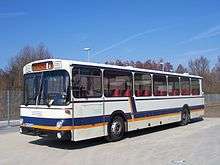
In Germany, students travel to school on scheduled public train and bus routes. In most cases, these services operate at times to suit school hours and are not run during weekends and holiday periods, though the services are open to use by non-school-related travellers. Local authorities subsidise the routes but parents or guardians are required to pay a contribution to the cost of a season ticket for use of the services. Many scholars use their own bicycles to travel to school and may take these with them when a part of the journey is by train.
As student transport is heavily dependent on the public transport system in urban areas, most students are transported on mass-transit or intercity buses along with minibuses in support. To distinguish themselves from other buses, routes that transport students are required to have a destination sign worded "Schulbus" with a yellow background. German traffic law gives traffic priority to school buses unloading and loading students; school buses are to warn traffic using their four-way hazard lights.
The maximum speed for German school buses varies. While coaches are typically limited to 80 kilometres per hour (50 mph), any buses with standing passengers are limited to 60 kilometres per hour (37 mph).
Italy
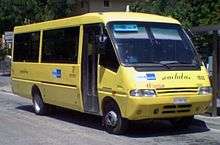
In Italy, school buses are typically painted yellow or orange. The vehicles used for student transport are usually minibuses or midibuses. As in North America, school buses run on fixed routes and stops.
While only a legal requirement for bus transporting Materne (preschool) students, school bus drivers are provided with an aide to manage the students on the bus.
Poland
In Poland, school buses are used in a similar fashion as those in the United States, to connect residents of rural areas to schools located far away. While officially lettered autobus szkolny (Polish for "school bus"), they are colloquially known as gimbus.
Along with their counterparts in North America, school buses in Poland have several design features to differentiate them from standard buses. First, all school buses are painted orange. Inside, the driver's compartment is not allowed to be blocked from the passenger compartment; however, any rear door must be able to be locked by the driver. All doors must lock at speeds above 5 kilometres per hour (3.1 mph).
Russia
In a fashion similar to school buses in North America, school buses in Russia are allowed to stop traffic (with both lights and alarms) when loading and unloading students at bus stops. School bus drivers are also accompanied by aides, who are given their own seating on the bus; buses also have onboard luggage space.
School buses transporting children are identified by the wording Перевозка детей (Transporting Children). All school buses are restricted to a maximum speed of 60 kilometres per hour (37 mph).
Prior to 1999, buses intended for transporting school children differed only in their route identification; no government regulations were required. In 2001, the Russian government began to acquire dedicated school buses, particularly to transport students in rural areas.
Ukraine
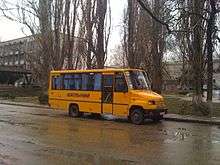
As in many other countries, in Ukraine, school buses are painted yellow or orange. In Ukrainian school buses are called "шкільний автобус".
United Kingdom
_2007_Volvo_B7R_Wright_Eclipse_SchoolRun%2C_4_September_2007.jpg)
In the United Kingdom, student transport by bus is usually provided by local scheduled public transport bus services. Dedicated bus services for school students are usually contracted out to local bus companies, using ordinary buses that are used for other purposes when not in use for school journeys.
During the 1990s, local governments began to establish a dedicated network of school bus service. To replace Leyland double-decker buses of the early 1980s, right-hand drive Blue Bird Corporation school buses were imported from the United States.[5][6] In the private sector, in 2000, FirstGroup launched First Student UK, using the same school bus yellow livery as on American school buses. While initially using right-hand drive Blue Bird TC/2000s imported from the United States, the company switched to Turkish-produced BMC 1100 buses later in the 2000s.
MyBus is a group of bus contractors (including First Student UK) that use school buses solely for school transport. Buses are fitted with seatbelts, and full-time drivers are assigned to each route.
Alongside importation of right-hand drive American vehicles and BMC-produced school buses, from 2006 to 2008, Wrightbus (of Northern Ireland) produced the Wright Eclipse SchoolRun. Adapting the Wright Eclipse into a high-floor design for school bus use, the SchoolRun was a 66-passenger bus, with 2+3 seating (most full-size American school buses have 3+3 seating) along with a side wheelchair lift (standard on the final 50 examples produced).
Children with more complex needs or disabilities are often transported to special schools in purpose-built minibuses. In a similar fashion to their counterparts in North America, these minibuses are school bus bodies fitted to full-size van chassis. In Europe, the Ford Transit and the Mercedes-Benz Vario are popular donor chassis for such vehicles.
- School Buses of the United Kingdom
_1986_Hong_Kong_tri-axle_(KMB_3BL64%2C_DH_5054)%2C_2012_Slough_%26_Windsor_running_day_(1).jpg) 1986 Leyland Olympian (imported from Hong Kong) in the United Kingdom
1986 Leyland Olympian (imported from Hong Kong) in the United Kingdom_1981_Bristol_VRT_SL3_ECW%2C_10_July_2006.jpg) 1981 Bristol VRT "BWS YSGOL" (Welsh translation of "school bus") in Wales in 2006
1981 Bristol VRT "BWS YSGOL" (Welsh translation of "school bus") in Wales in 2006%2C_12_May_2013.jpg) First Student Blue Bird TC/2000 in Essex; bus is imported from the United States.
First Student Blue Bird TC/2000 in Essex; bus is imported from the United States.%2C_Showbus_2004.jpg) First Student TC/3000 RE "BWS YSGOL" (Welsh School Bus); RHD Blue Bird All American
First Student TC/3000 RE "BWS YSGOL" (Welsh School Bus); RHD Blue Bird All American.jpg) Optare Versa Hybrid of Maytree Travel
Optare Versa Hybrid of Maytree Travel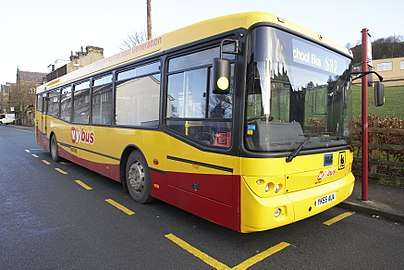 BMC220 of MyBus
BMC220 of MyBus.jpg) Plaxton Beaver on Mercedes-Benz chassis in London
Plaxton Beaver on Mercedes-Benz chassis in London%2C_10_september_2007_(1).jpg) Citroen Jumper school bus (Cunliffe & Son Vivre body)
Citroen Jumper school bus (Cunliffe & Son Vivre body)- 2000s Ford Transit in Northern Ireland
North America
Canada
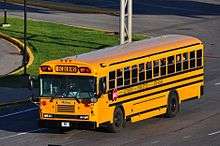
Canadian school buses are similar to their U.S. counterparts both in terms of overall design and their usage by school systems. The primary functional difference is the adaptation to the bilingual population of Canada. In francophone Quebec, the signage on the outside of the bus is in French; the front and rear legends read écoliers"—French for "Schoolchildren" ("School Bus" translated into French is the much longer "autobus scolaire"). The stop signal arm legend may read arrêt, French for "Stop", or may have both "stop" and "arrêt".[7] In addition, all emergency exit designations and instructions are required to be bilingual. Further safety requirements may be introduced at a provincial or even local level; for example, some coastal jurisdictions where fog is common insist on buses being fitted with roof-mounted strobe lights for use in poor visibility.[8][9]
As Canada does not use the customary system, instrument panel gauges are calibrated in metric units. School buses, like all other Canadian vehicles, are equipped with daytime running lights (DRLs). Older buses not equipped with DRLs are driven with headlights on.
Buses are sometimes marketed to customers in Canada differently from in the United States. In one example, the Blue Bird All American is rebadged as the Blue Bird TX3 in Canada (and other export markets). Additionally, of the three regionally focused brands sold by Collins Industries, only Corbeil is sold in Canada, due to its previous manufacturing base in Quebec.
The Lion Electric Company (in French, La Compagnie Électrique Lion) is a manufacturer based in Saint-Jérôme, Quebec that specializes in vehicles powered by battery-electric powertrains.
Mexico
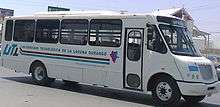
In Mexico, in addition to yellow school buses seen from the United States, various other types of buses are used in the role of student transport. As in the United States, many schools own their own fleets of school buses; school bus yellow is not a government regulation, so most buses are painted in individual school colors. Depending on capacity needs, vans, minibuses, and midibuses are also used. Among retired American school buses, some newer ones are imported into Mexico and put back into school service.
Unlike the United States and Canada, school-owned buses are not primarily used for route service (due to high cost); instead, they are often used for field trips and other related excursions. In addition to students using regular transit systems, several Mexican companies specialize in scheduled student transportation.
In Mexico City there is a special free bus service available to all the public in general; it is the "Puma-Bus" service, covering internal routes inside of the university complex located in "university city" at the south part of the same city, due to the extension of this scholar complex its operated in 10 routes that connect several points of the campus with Massive Transport Systems located near the complex (Metro, Metrobus and several local bus lines), all the routes operate from Monday to Friday, excepting those that gives services to cultural and sport centers, like the Universum Museum, Nezahualcoyotl Concert Hall and University Stadium. This service uses Low-Floor Mercedes Benz Citaro buses along with conventional units.
Oceania
Australia
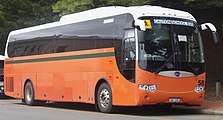
.jpg)
In Australia, school buses vary in colour with yellow buses being rare and are distinguishable from other buses by a yellow school zone sign or a sign that reads "School Bus" on the top rear end of the bus.[10][11] As school route buses are almost universally run by direct government contract,[12] the livery of the bus is generally that of the contractor, with the bus commonly also being used for normal scheduled routes as required. In NSW, however, the State Government has begun a program to bring all public transport in the state under one livery[13] including strict livery regulations for new vehicles purchased for government contract use.[14] The style is typically the same as public buses in other countries, as demonstrated in the picture from Wagga Wagga (which is in the livery of the local operator). Buses used on school routes are required to bear 40 km/h (25 mph) speed limit signs on their rear and to flashing yellow lights on the front and rear, similar to those in the US and other places. When stopping or stopped, the lights flash indicating other drivers must not travel past the bus in either direction faster than 40 km/h (the same speed limit is used in 'school zones' on roads adjacent to schools at times when most students are expected to be arriving or leaving). Drivers must also cede right of way to all buses (school or otherwise) attempting to pull out from a stop. Dedicated bus lanes are common in larger cities, where buses are also allowed to move off first from traffic lights before other traffic is shown a green light. Some areas also have dedicated busways. Increasingly, jurisdictions are requiring new buses purchased for use on school routes to be fitted with seat belts and 'compartmentalisation' features, or even requiring students to use seatbelts at all times.
Private and public schools often have 'activity' style buses, sometimes in a colour matching the 'school colours' although more commonly with just the name and logo of the school on the side and/or front of the bus to save the cost of custom painting. They are used by many schools for smaller excursions, i.e. to transport a single sport team or class, in order save on external hire costs and are consequently generally also driven by school staff. In order to allow staff to drive them with a standard car or light truck licence these vehicles are generally quite small, 22 seat buses are very common in this role.
The vast majority of schools in Australia (both government and private) do not have their own buses for transporting children between the school and their home and thus most school children in Australia that do travel by bus travel on public transport buses, either on standard scheduled public transport routes, or on specific 'school travel' routes. Most school routes do not allow the general adult public to ride along with the children, although this does vary by location according to practicality (i.e. remote areas) and local regulation.
Many Australian school children travel 'free' on non fare paying bus services[15] to their local school or using a bus pass that they get issued at the beginning of the school year that covers transport with the relevant bus (and often other public transport such as train or ferry) network/s for travel to and from school only, for which the contractor in turn receives a government subsidy amount for each trip,[16] although specifics of the schemes vary from state to state, some only providing subsidy to remote or low income families.[17] Many thousands of children in Australia thus have to travel daily to school using a number of different public transport routes with different bus, train, tram and ferry networks. In most places, as of 2013, this is even achieved with a single pass.
New Zealand
In New Zealand, student transport is sometimes provided by the New Zealand Ministry of Education through school bus contractors or general bus companies. Bus companies generally have a fleet of older transit buses or coaches, different from the newer public service fleet vehicles to cater for school services.
While carrying students, buses are marked by either "SCHOOL", "SCHOOL BUS", "KURA" (Maori for "school"), or pictograms of children in black on a fluorescent chartreuse background, and a limited on the open road to 80 km/h (50 mph) . These signs all indicate that a motorist should slow to 20 km/h (12 mph) when passing a stationary bus in either direction.[18][19]
References
- ↑ 校车安全事故频发折射监管缺位 超载现象严重 Retrieved 2012-3-10
- ↑ "Bigger nose means bigger safety for Qingdao school buses". chinadaily.com.cn. 6 June 2011. Retrieved 18 June 2011.
- 1 2 "China goes Schoolbus Crazy". Retrieved 31 December 2013.
- ↑ "American-Style Schoolbuses Make Inroads In China". Retrieved 31 December 2013.
- ↑ Di johan m b Nessun nome reale + Aggiungi contatto. "bluebird | Flickr –Condivisione di foto!". Flickr.com. Retrieved 2013-04-22.
- ↑ Di Wildmoreway Lena+ Aggiungi contatto. "Cheshire School Bus Bluebird V219EAL at Crewe (Flickr photo)". Flickr.com. Retrieved 2013-04-22.
- ↑ https://www.tc.gc.ca/eng/acts-regulations/regulations-crc-c1038.htm
- ↑ "District school buses to be fitted with strobe lights – Rainy River Valley Safety Coalition". safetycoalition.ca.
- ↑ http://www.qp.gov.sk.ca/documents/English/Regulations/Regulations/V2-1R10.pdf
- ↑ "Bus Australia Photo Gallery". bus australia. Retrieved 2013-10-20.
- ↑ http://acrs.org.au/about-us/policies/safe-vehicles/school-buses/
- ↑ "School bus contracts discourage fleet upgrades: MP". Abc.net.au. 2010-07-22. Retrieved 2013-04-22.
- ↑ "Out of the blue, more buses, all dressed alike". smh.com.au. 2010-12-22. Archived from the original on 2015-09-24. Retrieved 2013-10-20.
- ↑ "Sydney Metropolitan Bus Service Contract-Schedule 8" (PDF). Retrieved October 20, 2013.
- ↑ "Bus subsidy cuts hit students". smh.com.au. 2012-06-14. Retrieved 2013-10-20.
- ↑ "NSW School Student Transport Scheme". Retrieved 2013-10-20.
- ↑ "Queensland School Transport Assistance Scheme". Retrieved 2013-10-20.
- ↑ Speed limits on NZTA official New Zealand Road Code website, retrieved 2010-11-14
- ↑ See this article on an instance of Maori bus sign usage in Rotorua:Principal remains adamant over 'kura' bus signson Rotorua Daily Post website, retrieved 2010-11-14
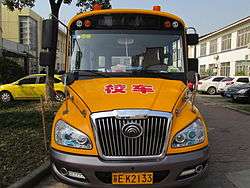
.jpg)